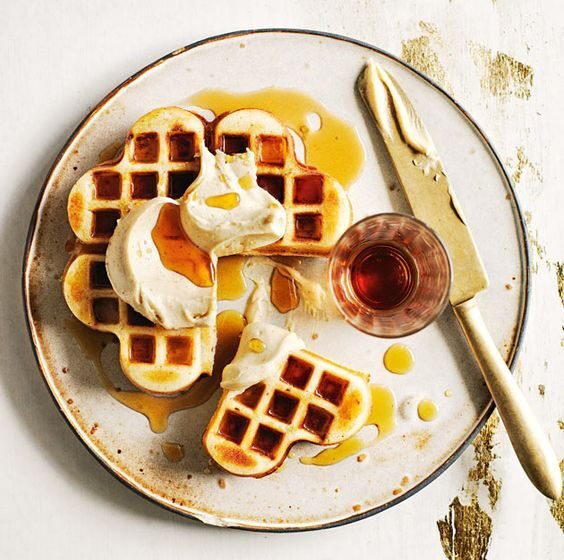Waffles: A Delicious Journey Through Time and Culture

Waffles, with their golden crispness and delightful pockets, have become a beloved breakfast and dessert treat enjoyed by people worldwide. But where did these delectable delights originate, and how did they evolve into the mouthwatering creations we relish today? In this blog, we embark on a fascinating journey through history and culture to explore the origins and evolution of waffles.

Ancient Origins of Waffle-like Treats
The roots of waffles can be traced back to ancient civilizations, where flatbreads were cooked on hot stones or griddles. Although not the waffles we know today, these early flatbreads served as the foundation for the development of this beloved dish.
- Ancient Greece: The ancient Greeks prepared obelios, a flat cake made from barley or wheat. While not precisely waffles, they were cooked between two hot metal plates and often drizzled with honey for sweetness.
- Ancient Rome: The Romans had a similar treat called “obeliscus” or “scribilia,” which was made using a mixture of water, milk, and flour. These cakes were frequently flavored with cheese and herbs.

Medieval European Influence
As trade and cultural exchange flourished during the medieval era, the concept of waffle-like treats spread across Europe. The term “waffle” itself can be traced back to the Old French word “walfre,” meaning “honeycomb” or “grid pattern.” Here are some notable milestones in the evolution of waffles during this period:
- Middle Ages: In medieval Europe, bakers started to use wafer irons to cook thin wafers, which were later folded or rolled. These wafers were commonly offered as sweet treats during religious festivals and special occasions.
- Pilgrims and the New World: The tradition of wafer-like treats accompanied European settlers to the New World. In the 17th century, pilgrims brought Dutch “wafles” to America, where they were gradually adapted to suit local tastes and ingredients.

Belgian Waffle Emergence
The rise of the Belgian waffle is a significant chapter in the history of this delectable treat. While waffles were already popular in various European countries, it was Belgium that gave the world the iconic Belgian waffle we know today.
- Belgian Waffle’s Antecedents: The first record of what can be identified as a “Belgian waffle” dates back to the 19th century when a Brussels chef named Walter introduced the “Gaufre de Bruxelles” at the Exposition Universelle (World Fair) in 1958. The Gaufre de Bruxelles was distinct from its predecessors due to its larger size, light and fluffy interior, and deep pockets.
- Brussels and Liege Waffles: The Gaufre de Bruxelles, which resembled the modern Belgian waffle, was known for its rectangular shape and deep grid pattern. On the other hand, the Liege waffle, originating from the city of Liege, was denser, sweeter, and often enriched with pearl sugar.
- Belgian Waffle’s Global Popularity: The Gaufre de Bruxelles gained international recognition and soon became synonymous with “Belgian waffle.” In the mid-20th century, Maurice Vermersch introduced the first waffle iron with a non-stick coating, revolutionizing waffle-making and boosting their popularity worldwide.

The Waffle House and American Influence
In the United States, waffles gained immense popularity during the 20th century, thanks in large part to the establishment of The Waffle House chain in 1955. This restaurant chain made waffles a staple in American households, introducing variations like pecan waffles and the iconic “smothered and covered” waffle toppings.
Additionally, the introduction of frozen waffles in the 1950s made waffles more accessible to home cooks, allowing them to enjoy this breakfast treat without the need for specialized equipment.

Modern Waffle Innovations
In recent decades, waffles have undergone further innovations, catering to diverse tastes and dietary preferences. Some notable modern waffle variations include:
- Belgian Liege Waffle: The Liege waffle, characterized by its rich, dense texture and caramelized sugar pockets, has gained popularity worldwide and is often served with a variety of toppings, from fruits to ice cream.
- Chicken and Waffles: A popular soul food dish in the United States, chicken and waffles combine the savory goodness of fried chicken with the sweet and crispy waffles, creating a delightful fusion of flavors.
- Vegan and Gluten-Free Waffles: With the rise of vegan and gluten-free diets, chefs and home cooks have developed plant-based and gluten-free waffle recipes to accommodate various dietary needs.

Conclusion
Waffles, with their origins in ancient civilizations and diverse cultural influences, have evolved into a beloved culinary delight enjoyed around the globe. From the early flatbreads of ancient Greece to the iconic Belgian waffles, and the American innovation of The Waffle House, this delectable treat has left an indelible mark on the world’s culinary landscape.

As we savor the delicious and crispy goodness of waffles, we are reminded of the rich history and cultural journey that have made them a cherished breakfast and dessert option. Whether enjoyed with sweet toppings like syrup and fruit or served alongside savory accompaniments like fried chicken, waffles continue to delight taste buds and bring people together in celebration of good food and shared experiences.


